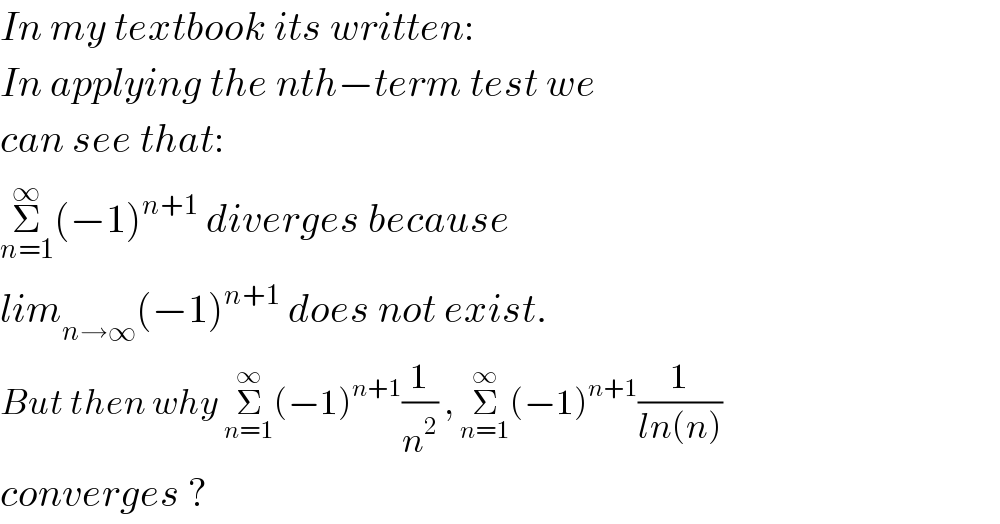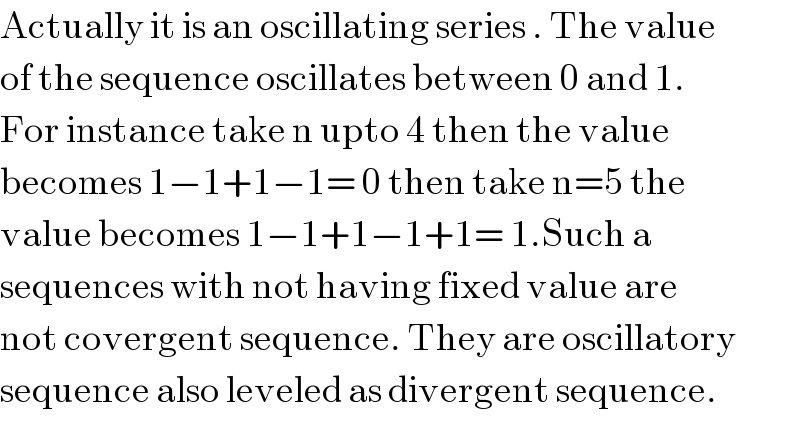
Question Number 68161 by Learner-123 last updated on 06/Sep/19

$${In}\:{my}\:{textbook}\:{its}\:{written}: \\ $$$${In}\:{applying}\:{the}\:{nth}−{term}\:{test}\:{we}\: \\ $$$${can}\:{see}\:{that}: \\ $$$$\underset{{n}=\mathrm{1}} {\overset{\infty} {\sum}}\left(−\mathrm{1}\right)^{{n}+\mathrm{1}} \:{diverges}\:{because}\: \\ $$$${lim}_{{n}\rightarrow\infty} \left(−\mathrm{1}\right)^{{n}+\mathrm{1}} \:{does}\:{not}\:{exist}. \\ $$$${But}\:{then}\:{why}\:\underset{{n}=\mathrm{1}} {\overset{\infty} {\sum}}\left(−\mathrm{1}\right)^{{n}+\mathrm{1}} \frac{\mathrm{1}}{{n}^{\mathrm{2}} }\:,\:\underset{{n}=\mathrm{1}} {\overset{\infty} {\sum}}\left(−\mathrm{1}\right)^{{n}+\mathrm{1}} \frac{\mathrm{1}}{{ln}\left({n}\right)} \\ $$$${converges}\:? \\ $$
Commented by Learner-123 last updated on 06/Sep/19

$${I}\:{can}\:{say}\:{with}\:{the}\:{similar}\:{argument} \\ $$$${that}\:{limit}\:{does}\:{not}\:{exist}\:\Rightarrow{diverges}. \\ $$
Commented by ~ À ® @ 237 ~ last updated on 06/Sep/19

$${Ascertain}\:{this}\:{to}\:{prove}\:{that}\:{the}\:{limit}\:{exist}\:{and}\:{its}\:{null} \\ $$$$−\mathrm{1}\leqslant\left(−\mathrm{1}\right)^{{n}+\mathrm{1}} \leqslant\mathrm{1}\:\Rightarrow\:\frac{−\mathrm{1}}{{n}^{\mathrm{2}} }\:\leqslant\frac{\left(−\mathrm{1}\right)^{{n}+\mathrm{1}} }{{n}^{\mathrm{2}} }\leqslant\frac{\mathrm{1}}{{n}^{\mathrm{2}} }\:\:\: \\ $$
Commented by mathmax by abdo last updated on 06/Sep/19

$$\sum_{{n}=\mathrm{1}} ^{\infty} \:\frac{\left(−\mathrm{1}\right)^{{n}+\mathrm{1}} }{{n}^{\mathrm{2}} }{converge}\:{absolutlly}\:{due}\:{to}\:\mid\frac{\left(−\mathrm{1}\right)^{{n}+\mathrm{1}} }{{n}^{\mathrm{2}} }\mid<\frac{\mathrm{1}}{{n}^{\mathrm{2}} } \\ $$$${and}\:\Sigma\:\frac{\mathrm{1}}{{n}^{\mathrm{2}} }{converges}\:\:\:{and}\:\sum_{{n}=\mathrm{1}} ^{\infty} \:\:\frac{\left(−\mathrm{1}\right)^{{n}+\mathrm{1}} }{{ln}\left({n}\right)}\:{is}\:{a}\:{alternate}\:{serie} \\ $$$${and}\:{verify}\:{the}\:{critere}\:{so}\:{its}\:{converges}. \\ $$
Commented by Learner-123 last updated on 06/Sep/19

$${Sir},\:{then}\:{why}\:\boldsymbol{\sum}_{{n}=\mathrm{1}\:} ^{\infty} \left(−\mathrm{1}\right)^{{n}+\mathrm{1}} \:{diverges}\:? \\ $$$${Does}\:{it}\:{follow}\:{alternate}\:{serie}? \\ $$
Commented by Prithwish sen last updated on 06/Sep/19

$$\mathrm{Actually}\:\mathrm{it}\:\mathrm{is}\:\mathrm{an}\:\mathrm{oscillating}\:\mathrm{series}\:.\:\mathrm{The}\:\mathrm{value} \\ $$$$\mathrm{of}\:\mathrm{the}\:\mathrm{sequence}\:\mathrm{oscillates}\:\mathrm{between}\:\mathrm{0}\:\mathrm{and}\:\mathrm{1}. \\ $$$$\mathrm{For}\:\mathrm{instance}\:\mathrm{take}\:\mathrm{n}\:\mathrm{upto}\:\mathrm{4}\:\mathrm{then}\:\mathrm{the}\:\mathrm{value} \\ $$$$\mathrm{becomes}\:\mathrm{1}−\mathrm{1}+\mathrm{1}−\mathrm{1}=\:\mathrm{0}\:\mathrm{then}\:\mathrm{take}\:\mathrm{n}=\mathrm{5}\:\mathrm{the} \\ $$$$\mathrm{value}\:\mathrm{becomes}\:\mathrm{1}−\mathrm{1}+\mathrm{1}−\mathrm{1}+\mathrm{1}=\:\mathrm{1}.\mathrm{Such}\:\mathrm{a}\: \\ $$$$\mathrm{sequences}\:\mathrm{with}\:\mathrm{not}\:\mathrm{having}\:\mathrm{fixed}\:\mathrm{value}\:\mathrm{are} \\ $$$$\mathrm{not}\:\mathrm{covergent}\:\mathrm{sequence}.\:\mathrm{They}\:\mathrm{are}\:\mathrm{oscillatory} \\ $$$$\mathrm{sequence}\:\mathrm{also}\:\mathrm{leveled}\:\mathrm{as}\:\mathrm{divergent}\:\mathrm{sequence}. \\ $$
Commented by Learner-123 last updated on 06/Sep/19

$${Ok},{thank}\:{you}\:{all}! \\ $$
Commented by mathmax by abdo last updated on 06/Sep/19

$${no}\:{sir}\:\:{the}\:{sequence}\:\:{u}_{{n}} =\left(−\mathrm{1}\right)^{{n}+\mathrm{1}} \:{diverges}\:\:{because}\:{the}\:{extract} \\ $$$${sequence}\:{dont}\:{go}\:{to}\:{tbe}\:{same}\:{limit}\:{look} \\ $$$${lim}_{{n}\rightarrow+\infty} {u}_{\mathrm{2}{n}} =−\mathrm{1}\:\:{and}\:{lim}_{{n}\rightarrow+\infty} {u}_{\mathrm{2}{n}+\mathrm{1}} =\mathrm{1} \\ $$
